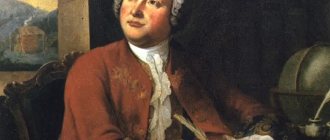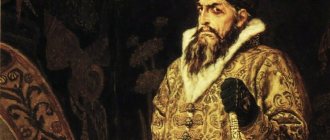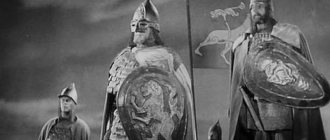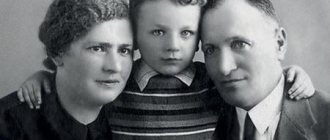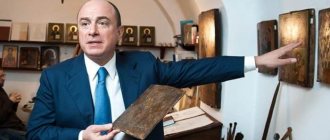Biography of Mikhail Lomonosov
Mikhail Vasilyevich Lomonosov is an outstanding and exceptionally versatile polymath scientist who has shown his talent in almost all branches of science, a reformist of the Russian language, an artist and educator, a phenomenon centuries ahead of his time.
Mikhail Vasilievich Lomonosov
He founded the chemical laboratory of the Academy of Sciences, was the author of the famous Moscow State University project, and made many discoveries in the field of chemistry, navigation, geology, philology, meteorology, and astronomy. Among his achievements are the fundamentals of atomic-molecular science, the theory of light and color, the discovery of the electrical nature of lightning and the invention of the lightning rod, the improvement of telescope designs and the discovery of the presence of an atmosphere on the planet Venus. And to this day he is rightly considered one of the brightest geniuses of humanity.
Childhood
The future academician was born on November 19, 1711 in the northern outskirts of the empire, in the Arkhangelsk province, namely in the village of Mishaninskaya, located on Kurostrov in the lower reaches of the Northern Dvina.
His father Vasily Dorofeevich was a hard-working, courageous, strict, but kind and religious man. Coming from a peasant family, he was engaged in hunting and fishing, which was dangerous in the harsh northern seas, and had his own ship, land, house, and farm, acquired through hard work. He was the first of the Pomors to build a “Gukor” type vessel, with which he not only caught fish, but also delivered cargo.
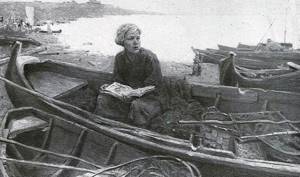
Mikhail Lomonosov in his youth
Mikhail’s mother, Elena Ivanovna, the daughter of a mallow-widow deacon from a nearby village, was not inferior to her husband in hard work and was a caring and loving mother.
The only son of the Lomonosovs grew up as a smart, inquisitive and sensible child. He learned everything quickly, from childhood he helped his parents around the house, and as a teenager he went hunting with his father and on boats to fish. However, his carefree childhood ended in 1720 when his mother died. The father brought first one, and after her death, a second stepmother, which made his home strange and cold for the boy.
Secrets of birth: nugget or bastard?
Officially, Lomonosov is considered the son of Pomor (a rare ethnographic group living on the coast of the northern seas of the White and Barents seas and the rivers Pechora, Onega, etc.) Vasily Dorofeevich Lomonosov. He was in no hurry to get married because he was poor. Only at the age of 30 did he marry Elena Sivkova, the daughter of a parish deacon. The future luminary of Russian and world science was born on November 19, 1711. By some miracle, such a bright mind could appear in the family of an almost illiterate peasant who lived as a fisherman and a religious woman.

It is also puzzling that the son of a commoner was able to enter the Academy in Moscow, which was a privilege only for nobles and high clergy, and later earn a noble title. By the way, the surname Lomonosov, and not Dorofeev, was assigned, according to one version, to Mikhail Vasilyevich due to the fact that his father had a hot temper and literally “broke the noses” of his opponents.
Some historians, in attempts to explain this phenomenon, even dare to attribute the paternity of Lomonosov to Peter I. Peter Alekseevich indeed often visited those places and worked at the Bazhenov shipyard nearby. However, this version is just unconfirmed speculation, so everyone decides for himself how much truth he wants to see in them.
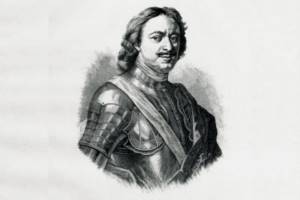
The path to science
Mikhail began to master literacy at the age of 12. His mentor was clerk Sabelnikov. Soon Misha became known as his best student and read all the books he and his fellow villagers owned. His son's stubborn pursuit of knowledge was not encouraged by his father and stepmother. They were going to marry him as soon as possible.
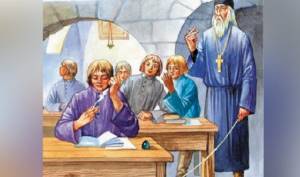
Mikhail Lomonosov began to master literacy at the age of 12
At the end of 1730, the young man received a passport and left with a trade train for knowledge in Moscow. After 3 weeks, he arrived in Belokamennaya and appeared at the Zaikonospassky Monastery, where the first university in Russia was located - the Slavic-Greek-Latin Academy. Children of peasants were not accepted there, but the young man managed to do something incredible - he introduced himself as the son of a nobleman.
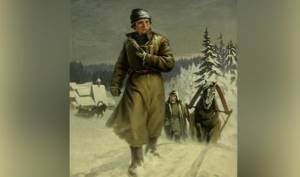
At the age of 19, Mikhail Lomonosov went to Moscow for knowledge
After three years, he wrote in Latin, mastered theology, poetry, and natural sciences. In 1734, the young man entered the Kiev-Mohyla Academy, where he continued his education. In 1735, he began studying at the university at the Academy of Sciences in Northern Palmyra, and a year later he was sent to study in Germany.
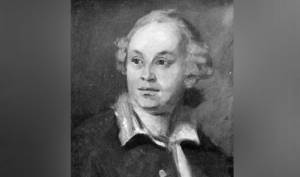
Mikhail Lomonosov studied natural sciences in Europe
In the period 1736-1739. the aspiring scientist studied natural sciences in the largest university cities in Europe: in Marburg under the guidance of the encyclopedist Christian von Wolf and in Freiberg under the mining adviser to the Saxon government Johann Henkel. In parallel with the main course and the preparation of innovative research in chemistry and physics, he became acquainted with Western European literature, was engaged in poetic translations, and developed a system of so-called syllabic-tonic versification.
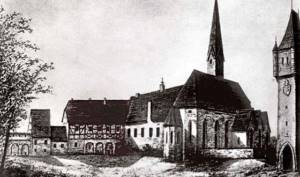
View of the University of Marburg, where Lomonosov studied
Mikhail has always been distinguished not only by his extraordinary abilities, but also by his courageous behavior. As a result of a quarrel with Henckel in 1740, he left Freiberg and went home, but on the way he was forcibly recruited into the Prussian Royal Army. Soon he managed to escape to Marburg, and a year later returned to St. Petersburg.
Advances in science
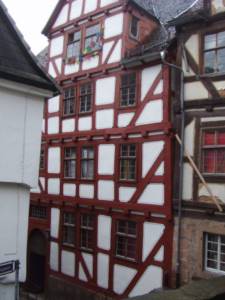
The house where Lomonosov lived in Marburg
Lomonosov began to study science seriously in 1737-1738. While studying abroad, he wrote his first works. The debut work of the novice scientist was called “On the transformation of a solid into a liquid, depending on the movement of the preceding liquid” and was devoted to various states of aggregation.
His next research was a dissertation in 1745 on the topic “On Metallic Luster,” which earned him a professorship and the title of nobleman. All Lomonosov's scientific works are distinguished by their accuracy. In his research and calculations, he almost never made mistakes.
The main discoveries of the scientist in the field of natural science:
- made colored glass and paints;
- subjected the ore to chemical analysis;
- formulated the foundations of the kinetic theory of gases;
- discovered the law of conservation of energy;
- explained the mystery of thunderstorms and the northern lights;
- invented the basics of physical chemistry.
Lomonosov supported the works of Copernicus, so he also studied astronomy. He discovered the atmosphere on Venus, improved the mechanism of the reflective telescope (the modern name is the Lomonosov-Herschel system) and organized many scientific expeditions. It was also he who was the first to guess that the Sun star is a huge ball of fire.
The scientist proposed many innovative ideas in the field of Russian grammar, making it more scientific. Thus, he introduced a number of new concepts, for example, horizon, atom, molecule, temperature. The scientist’s mind and ideas were very ahead of his time, so many of his works were published after his death.
Lomonosov prepared and published many textbooks on chemistry, physics, metallurgy, and organized many chemical production facilities. His creative abilities were also highly appreciated. The scientist is also known as a poet and artist.
Scientific luminary
Upon arrival, within a year, the student, who had defied the teacher and voluntarily interrupted his studies in Germany, presented dissertations in chemistry and physics to the academicians.
In 1742, he managed to earn the position of adjunct of the Physics class, began research, experiments, astronomical observations, and giving public lectures in his native language. A year later, Mikhail showed his indomitable temper by staging a violent speech, with selective abuse, against the dominance of mediocre German professors within the walls of the educational institution. And again, miraculously, he managed to avoid the hard labor imposed for such an offense (although he ended up in custody for some time).
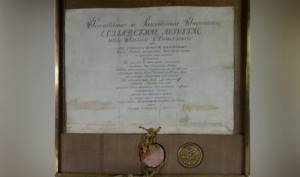
Diploma issued to Mikhail Lomonosov by the Academy of Sciences for the title of Professor of Chemistry
In 1745, the 34-year-old polymath, having defended a number of works, became a professor of chemistry and received a noble title. He combined his intensive scientific activity with literary creativity. In 1748, the scientist founded the country's first chemical laboratory, embodying the revolutionary principle of integrating science and practice. At the same time, he translated Homer, Horace, Virgil, Seneca, Rousseau, wrote odes imbued with patriotic pathos, poems of high civic sound and other works, including the famous “Rhetoric” with fundamental studies of the treatises of the best orators of antiquity and the formulation of the principles of eloquence.
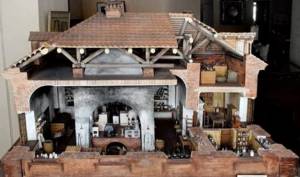
Model of Mikhail Lomonosov's chemical laboratory
After delivering a “Laudatory speech to Empress Elizabeth Petrovna,” he was awarded the rank of collegiate adviser in 1749. Many outstanding lines belong to his pen: “Sciences nourish youths, give joy to elders...”, “And the Russian land can give birth to its own Platos and quick-witted Newtons.”

Mikhail Lomonosov in the chemical laboratory
In 1751, the academician became the founder of not only scientific but also physical chemistry - he was the first scientist to give students a course of lectures on this topic, accompanied by demonstrations of experiments. He designed instruments for research, in particular, invented a pipe that made it possible to distinguish objects at dusk, studied atmospheric electricity, gravity, the nature of the northern lights, and revived the art of mosaic.
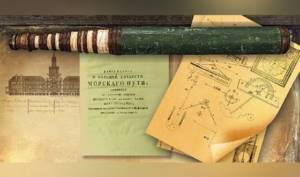
Lomonosov telescope
In 1755, the brilliant scientist initiated the establishment of a university and laid down the basic principles of higher education - accessibility and fundamentality. In 1757, he became a member of the Academy's chancellery and published the “Russian Grammar,” distinguishing between the Church Slavonic and Russian languages, identifying its dialects, forms, and styles.
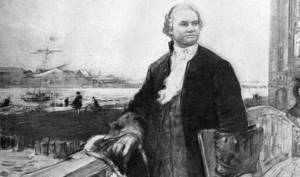
Mikhail Lomonosov in front of the Academy of Sciences
Mikhail Lomonosov led a number of formations at the Academy, including the Geographical Department and the Historical Collection, created an atlas of the country, a classifier of earthquakes, and published a work on calculations of the sea route and methods of finding geographic coordinates.
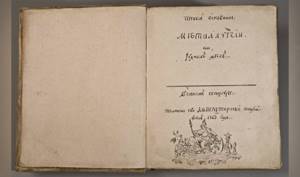
“The first foundations of metallurgy or ore mining” by Lomonosov
In 1763, his opus about travels across the northern seas was published, followed by his works “On the Layers of the Earth” and “The First Foundations of Metallurgy or Mining.” Catherine II, who ascended the throne, appreciated his brilliant and unparalleled activity and granted him the rank of state councilor.
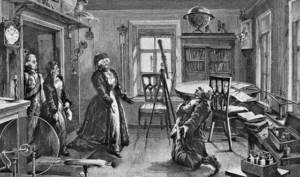
Visit of Mikhail Lomonosov by Empress Catherine II
Personal life of Mikhail Lomonosov
The professor was a monogamous man: he married during his student years, while staying in Marburg, and remained faithful to his wife all his life. His chosen one was the daughter of his landlords, Elizaveta Tsilkh. They married in 1740. The couple had three children, but only their daughter Elena, born in 1749, survived.
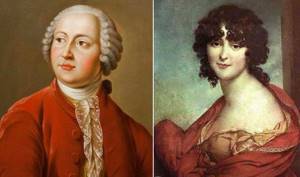
Mikhail Lomonosov and his wife Elizaveta Tsilkh
There is evidence that the academician attended social functions with his wife. At one of the balls, Empress Elizaveta Petrovna presented her with a beautiful fan.
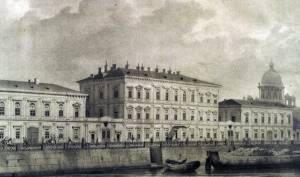
House of Mikhail Lomonosov on the Moika River, St. Petersburg
Lomonosov's daughter grew up to be a highly educated girl, she knew languages, literature, and music. A month before his death, her father blessed her to marry the librarian of the Imperial Library, 21 years older than her, Alexei Konstantinov. Elena gave birth to a son and three daughters. She, like Mikhail Vasilyevich’s mother, died young, at 23 years old.
Educational institutions in Lomonosov's biography
Mikhail ran away from home in December 1730. He took with him some clothes, books donated by a neighbor, and went on foot to the capital. On the way, he was lucky enough to meet a fish train, with which he continued on his way.
He managed to get to Moscow only three weeks later, at the beginning of 1731. To enter the Slavic-Greek-Latin Academy, the young man had to say that he was the son of a Kholmogory nobleman and forge documents.
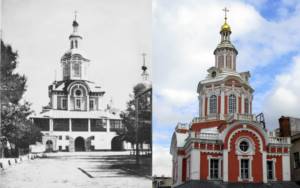
It was not easy for him in school. The lack of money provoked ridicule from classmates. However, thanks to his great thirst for learning and unique abilities, six months later the boy was already transferred to the second grade, and almost immediately to the third.
Lomonosov devoted a lot of time to self-education. He studied ancient chronicles, patristics and other theological literature in one of the monasteries. He was also interested in ancient Russian books of various genres, publications of philosophical, technical and secular content.
Thanks to the Moscow Academy, Mikhail was able to receive a humanitarian education. However, Lomonosov did not want to stop there, because he had a great interest in the natural sciences. He decided to continue his studies at the Kiev-Mohyla Academy, but stayed there for only a few months. He was lucky enough to learn the basics of technical and natural sciences in St. Petersburg, where he was sent after returning to Moscow from Kyiv.
Death
In the last years of his life, the brilliant encyclopedist became an honorary member of the Swedish and Bologna (Italy) academies of sciences, and also presented an outstanding study “Ancient Russian History”, outlining the principles of development and questions of the origin of the country.
The greatest scientist in the city on the Neva died at the age of 54 from pneumonia.
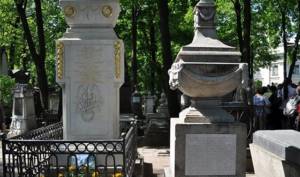
Mikhail Lomonosov was buried at the Lazarevskoye cemetery of the Alexander Nevsky Lavra
The only known direct descendant of Lomonosov living today is the Estonian director and musician Peeter Volkonsky (born 1954).
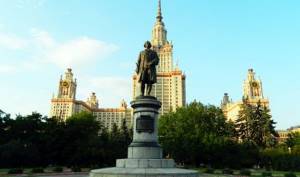
Monument to M.V. Lomonosov in Moscow
